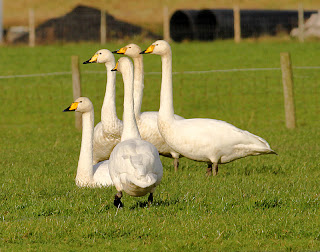It was still breezy this morning but bright with it, perhaps the nicest morning we’ve had for some weeks; let’s hope it’s an omen for the New Year. I decided a tramp across Rawcliffe Moss would be both beneficial to me and productive for finding birds, an idea which proved to be fairly accurate although I didn’t need the calculator of Wednesday’s swan day, just the fingers of one hand this morning. My thanks go to Grace in Maine for that last piece of advice; over in Maine the folks are whizz at counting the depth of the snow in metres, and often need to use all ten fingers.
The first bird/birds of the day can be a pointer to what’s to come later: migrants overhead, thrushes in a dawn hedgerow, a hunting Barn Owl or a dawn chorus. Today it was a Buzzard, or rather a Buzzard and several Blackbirds in my field of view at once, the Buzzard perched motionless in a tree but watching the antics of the thrushes fighting over the few remaining berries along the hedgerow below. It was too early for the Buzzard to fly, and often they just sit and wait, so inconspicuous are they, despite their size.

Next in my notebook came Hen Harrier again, the now regular “ringtail” floating across the road ahead of me as it hurried across to Pilling Moss, its main hang out of the past month or so. Later I was to see the harrier make the return journey, helped this time by a convoy of corvids that chased it mercilessly until it was off their feeding stubble.
By now I was at the Tree Sparrow track, where I headed east along the hedge to see how many flushed off the seed. 180 was the answer, eight or nine flights of twenty heading for the safety of the next hedgerow and away from bird ringers. A number of Chaffinch were amongst the sparrows, as well as a few Yellowhammers, but on a return viewing an hour or more later the Chaffinch count increased to 30+, Yellowhammers to 16, and Reed Buntings to 10.


Next came the big field and then a slog north over wet stubble where I came across a Merlin, a Kestrel, 8 Corn Bunting, another dozen or so Reed Buntings, 5 Linnet, 7 Grey Partridge, 15 Skylark and 7 Roe Deer. Although the birds scatter along the hedgerow, the deer never ever stay around, but just run and run to the safety of a distant wood.

As the light burst through the sky and the sun hit the abandoned maize, I took a black and white photo that turned out ok, and then a colour one that isn’t nearly so intense.


A walk through and around the winter plantation yielded 6 Reed Bunting, 3 Blackbird, a Robin, a Sparrowhawk, and in distant trees 500+ Wood Pigeon. Hey Grace, I almost needed an abacus for those last ones.












































.jpg)












